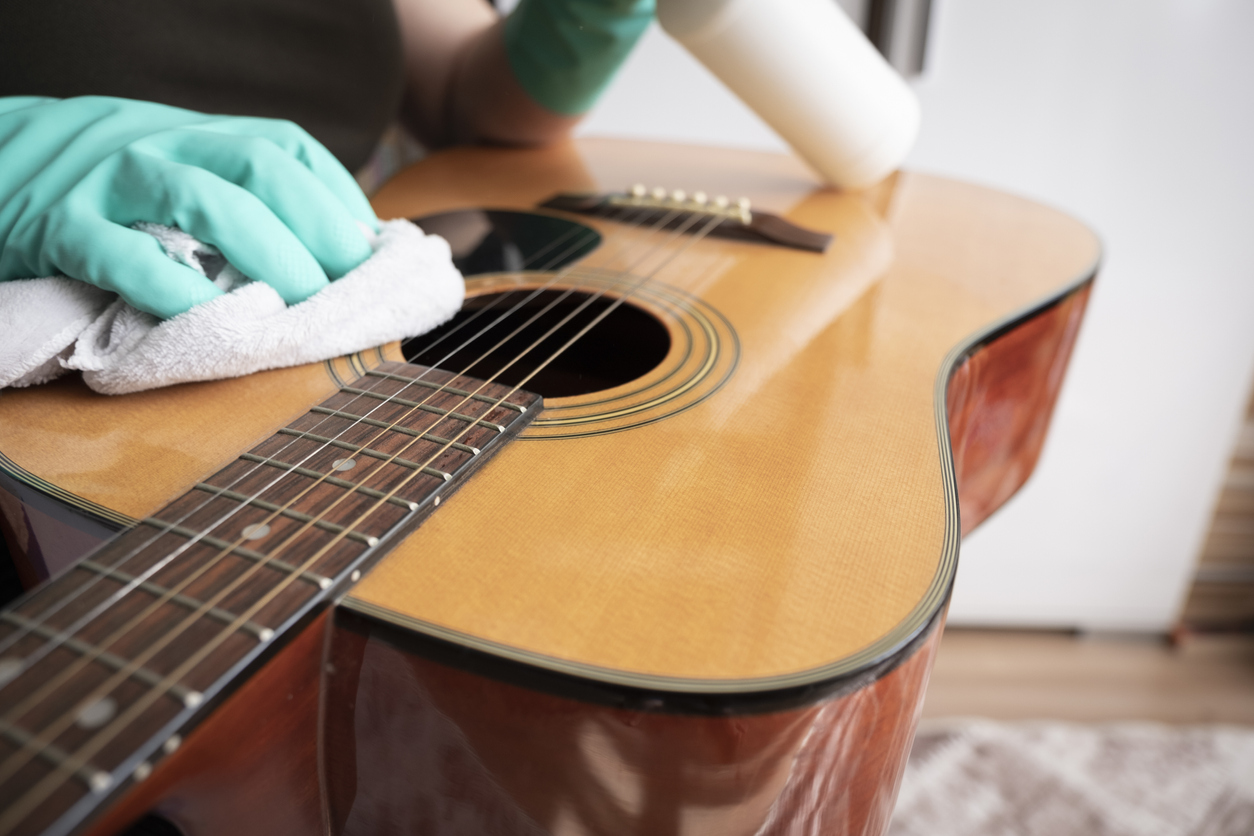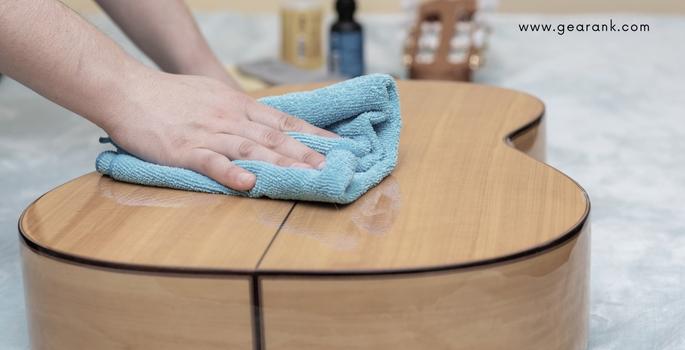So you’ve finally mastered Wonderwall, found your inner rock god, and are ready to take on the world with your sick guitar skills. But before you start shredding like a maniac, it’s important to learn the ABCs of guitar care. From cleaning off the six layers of Cheeto dust to changing those grimy strings that have seen better days, we’ve got you covered. Get ready to rock and roll (after a quick lesson in guitar hygiene, of course).
Contents
- 1 Understanding the Importance of Routine Guitar Maintenance
- 2 Selecting the Right Cleaning Supplies for Your Guitar
- 3 Step-by-Step Guide to Cleaning Your Guitar
- 4 Evaluating When to Change Your Guitar Strings
- 5 Navigating the Process of Changing Guitar Strings
- 6 Advanced Care Tips for Long-Term Guitar Maintenance
- 7 Addressing Common Guitar Maintenance Misconceptions
- 8 FAQs
- 9 Strumming Along with your Sturdy Strings
Understanding the Importance of Routine Guitar Maintenance
Alright fellow guitar enthusiasts, let’s talk about the importance of routine guitar maintenance. We all know how much we love our trusty instruments, so why not show them some love too?
First things first, a well-maintained guitar will not only sound better but will also last longer. Who wants a rusty, out-of-tune guitar causing a ruckus during a jam session? Not us! Keep that baby in tip-top shape and you’ll be shredding like a rockstar for years to come.
Regular maintenance also helps prevent bigger issues down the line. Trust me, you do not want to be caught off guard with a broken string mid-performance. Ain’t nobody got time for that! A little TLC now will save you a headache later.
So, what are you waiting for? Grab your guitar, dust off those strings, and show it the attention it deserves. Whether you DIY or take it to a professional, just remember – a well-maintained guitar is a happy guitar!
Selecting the Right Cleaning Supplies for Your Guitar
When it comes to keeping your guitar in tip-top shape, selecting the right cleaning supplies is crucial. You don’t want to use just any old rag or spray on your beloved instrument - no, no, no! Your guitar deserves the royal treatment, so it’s time to stock up on the best cleaning supplies money can buy.
First things first, you’ll need a microfiber cloth to gently wipe away any dust and fingerprints. This soft little gem will leave your guitar looking shiny and new in no time. Just make sure to resist the urge to use your aunt’s old dish rag – your guitar deserves better!
Next, you’ll want to invest in a guitar polish that is specially formulated for your instrument’s finish. This magical elixir will make your guitar gleam like a diamond in the rough. Just a few spritzes and a quick buff with your microfiber cloth, and voila! Your guitar will be the envy of all the other instruments in the band.
And let’s not forget about the fretboard cleaner – that poor neglected part of your guitar that gets all grimy from your sweaty fingers. A gentle scrub with a specially formulated fretboard cleaner will have your frets shining brighter than a shooting star. Your guitar will thank you by playing like a dream!

Step-by-Step Guide to Cleaning Your Guitar
So, your guitar is looking a little worse for wear, huh? Fear not, my friend! Here’s a foolproof guide to getting your beloved instrument shiny and clean once again.
Gather Your Supplies:
- Microfiber cloth
- Guitar polish
- Fretboard cleaner
- Toothbrush (not your own, of course)
Dust off that Baby:
Start by giving your guitar a good dusting with a microfiber cloth. Pay special attention to those hard-to-reach places like under the strings and around the headstock. Get rid of all that gunk that’s been accumulating for who knows how long.
Show Your Fretboard Some Love:
Next up, treat your fretboard to some TLC. Use a little fretboard cleaner and a toothbrush to gently scrub away any built-up grime. Your fretboard will thank you by looking and feeling brand new.
Polish it Up:
Finally, give your guitar a good polish with some guitar polish. Make sure to buff it to a shine so bright, it’ll blind anyone who dares to look at it. Your guitar will be gleaming like a diamond in no time.

Evaluating When to Change Your Guitar Strings
So, you’ve been jamming out on your guitar for months on end, but have you taken a moment to really evaluate the state of your trusty strings? Here are a few signs that it might be time to give those bad boys a refresh:
- **Rust and grime**: If your strings are starting to look more like spaghetti that’s been sitting in your cupboard for a few years, it’s probably time to change them out. Rusty, grimy strings not only sound terrible, but they can also wreak havoc on your fingers.
– **Tuning troubles**: Are you finding yourself constantly retuning your guitar, only to have it sound like a hot mess five minutes later? This could be a sign that your strings are losing their elasticity and it’s time for a change.
– **Dull sound**: If your guitar is sounding more like a tin can than a beautiful melody maker, it’s a pretty good indicator that your strings have seen better days.
– **Broken strings**: This one might seem obvious, but if you’re finding yourself breaking strings left and right, it’s definitely time to invest in a new set. Remember, guitar strings are not spaghetti – they’re not meant to snap at the drop of a hat.
Take a moment to give your strings a little TLC – your guitar (and your ears) will thank you!
So you’ve decided it’s finally time to change those crusty, ancient strings on your guitar. Congratulations! You’re about to embark on a journey that will test your patience, sanity, and possibly your ability to hold back tears. But fear not, with a little bit of perseverance and a whole lot of cursing, you’ll soon have your guitar sounding fresh and ready to rock.
First things first, gather your supplies. You’ll need a set of new strings (duh), a pair of wire cutters, a tuner (unless you have perfect pitch, in which case, we hate you), and a strong stomach for the horrors that await you beneath your guitar’s strings. And don’t forget to clear your schedule for the next few hours, because this process is about to become your new full-time job.
Next, it’s time to remove the old strings. This part is like untangling a pile of Christmas lights, except instead of festive cheer, you’re met with a tangled mess of metal and regret. Carefully unwind each string, being sure to avoid snapping them into your eyeballs (trust us, it’s not a fun experience). Once you’ve successfully removed all the old strings, take a moment to reflect on the journey you’ve just embarked on. Was it worth it? Only time will tell.
Now comes the fun part: stringing your guitar with the new set. This is where the real magic happens (or the real disaster, depending on how well you’ve been following along). Channel your inner guitar tech and carefully thread each string through the appropriate peg, making sure not to twist them into a hot mess. Tune your guitar, give it a strum, and bask in the glory of your newfound string-changing expertise. Congratulations, you survived the process! Now go forth and serenade the world with your freshly strung masterpiece.
Advanced Care Tips for Long-Term Guitar Maintenance
Guitars are like pets, they need love and attention to thrive. Here are some advanced care tips for those who want their beloved instrument to last a lifetime:
- Keep it clean: Dust and dirt can build up on your guitar, affecting the sound quality and appearance. Regularly wipe down your guitar with a soft cloth to keep it looking and sounding its best.
- Check the humidity: Guitars are sensitive to changes in humidity, which can cause warping and cracking. Invest in a humidifier or dehumidifier to keep your guitar in tip-top shape.
- Get a setup: Treat your guitar to a professional setup every once in a while. A qualified technician can adjust the action, intonation, and neck relief to ensure optimum playability.
Remember, a well-maintained guitar is a happy guitar. So don’t neglect your instrument – show it the love and care it deserves!
Addressing Common Guitar Maintenance Misconceptions
So you think you know everything there is to know about guitar maintenance, huh? Well, think again! There are some common misconceptions floating around that need to be addressed. Let’s debunk some of these myths and set the record straight.
First up, let’s talk about the good ol’ guitar strings. Contrary to popular belief, you don’t need to change your strings every time you pick up your guitar to play. Yes, they do wear out over time, but unless they’re visibly rusted or sound dull, you can probably get away with changing them less frequently. So go ahead, give those strings a break!
Next on the list is the infamous guitar humidifier. Some people swear by them, claiming they’re essential for preserving the wood of your guitar. But unless you live in an extremely dry climate or your guitar is stored in less than ideal conditions, you probably don’t need to invest in one. Your guitar will survive without it, trust me.
And finally, let’s address the myth that you need to clean your guitar with fancy, expensive products. The truth is, you can simply use a soft, lint-free cloth to wipe down your guitar after playing, and maybe the occasional damp cloth for tougher spots. No need to spend a fortune on specialized guitar cleaners – your guitar won’t know the difference!
FAQs
What is the best way to clean my guitar?
Well, first things first, your guitar is NOT a plate. So don’t try washing it in the sink. Instead, grab yourself a soft microfiber cloth and gently wipe down the body, neck, and strings to remove any smudges or fingerprints. If it’s really filthy, you can use a damp cloth with a little bit of guitar polish, just make sure to dry it off right away so it doesn’t get waterlogged – we’re talking about cleaning, not drowning.
How often should I change my guitar strings?
Are your strings starting to resemble a rusty old fence wire? Then it’s probably time for a change, my friend. The general rule of thumb is to change your strings every 1-3 months if you play regularly. But if you’re more of a casual strummer, you can probably stretch that out to every 6 months or so. Just remember, old strings = bad sound, so don’t wait until your guitar starts sounding like a dying cat.
What’s the deal with humidifying my guitar?
Think of humidifying your guitar like giving it a relaxing spa day. Guitars love to be pampered, and keeping them in the right humidity range (around 45-55%) will prevent warping, cracking, and other disasters. You can invest in a fancy guitar humidifier, or you can just stick a little sponge in a plastic baggie and call it a day. Your guitar will thank you by staying in tune and sounding sweet.
How can I protect my guitar from scratches and bumps?
Let’s face it, guitars are delicate creatures. One little dent, and they’re off to the guitar graveyard. To protect your beloved axe, consider investing in a padded gig bag or hardshell case. And please, for the love of all that is rock and roll, don’t lean your guitar against the wall like it’s a forgotten piece of furniture. Use a guitar stand or wall mount to keep it safe and sound when you’re not shredding.
Do I really need to set up my guitar professionally?
Well, unless you fancy yourself a guitar whisperer, it’s probably best to leave the setup to the pros. A well-set-up guitar will play like a dream, with perfect intonation and action that won’t make your fingers bleed. Plus, a good setup can prevent all sorts of issues down the road, like buzzing frets and wonky tuning. So do yourself (and your guitar) a favor and shell out a few bucks for a professional setup – your fingers will thank you.
Strumming Along with your Sturdy Strings
Now that you’ve mastered the basics of guitar care, you can keep your instrument in tip-top shape and your music sounding sweet. Remember to show your guitar some love with regular cleaning, string changes, and maintenance. With a little TLC, your six-stringed companion will reward you with beautiful melodies for years to come. So go ahead, start strumming and let your guitar shine!



